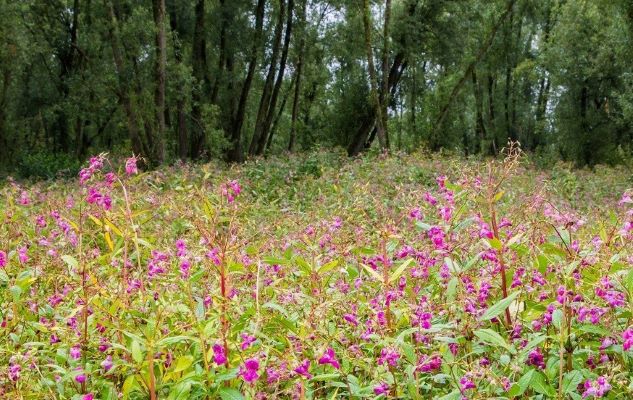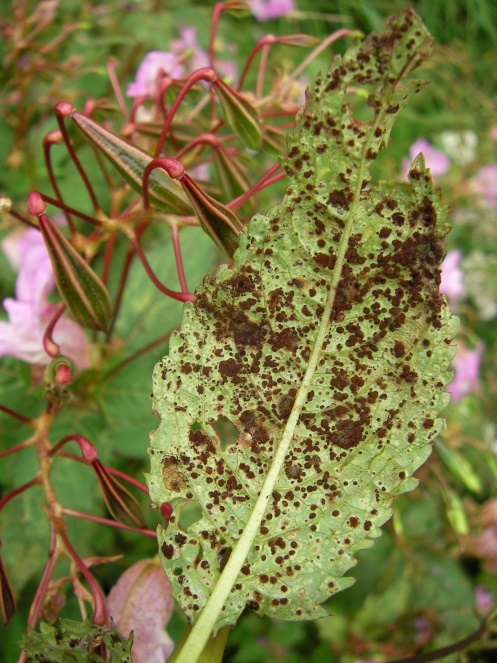With its bright pink flowers and fairly common appearance in Europe, and North America, when Himalayan balsam blossoms it can grow up to two metres tall with rough, reddish stems and shiny oval-shaped leaves. As alluring as it sounds, this plant, frequently found along waterways or damp areas, is highly invasive and causes a number of negative effects.
As part of a new CABI podcast series, we interviewed CABI experts Dr Sonal Varia and Kate Pollard, who detailed the problems caused by the plant, and how they are combating it’s spread through their work with CABI.

Welcome Dr Sonal Varia and Kate Pollard . Please, introduce yourselves…
Dr Sonal Varia: I’m a weed biocontrol scientist. I’ve worked at CABI for 12 years and I actually started working on the Himalayan balsam when I was an intern.
Kate Pollard: I’m a research scientist and I work within the weeds biocontrol group at CABI in Egham. I’m a plant pathologist by training and work on using fungal agents for the classical biological control of invasive weeds. I’ve been at CABI for 8 years and, like Sonal, I worked on the Himalayan balsam project when I first started here.
What is Himalayan Balsam, and how did it first arrive in Europe?
Dr Sonal Varia: Himalayan balsam, or impatiens glandulifera, is a non-native invasive weed from the foothills of the Himalayan region in India and Pakistan. It was first introduced to Europe in the 19th century by Victorian plant hunters as an ornamental plant because of its beautiful flower. It’s a close relative of the busy lizzie, a popular plant in horticultural industry.
What sort of problems does it cause?
Dr Sonal Varia: Himalayan balsam can have many negative impacts on biodiversity because it can grow in very dense monocultures where few other species can. Not only does it compete with native plant species for light and space, but, with a really high nectar content, it also attracts pollinators such as bees over native flowers. Each plant can produce hundreds of seeds, which in a riverined habitat allows it to easily reinvade nearby areas, making it difficult to control.
What has CABI been doing to control its spread?
Kate Pollard: We are looking to control Himalayan balsam using classical biological control in the form of rust fungus from the Himalayas. The aim is for it to reduce populations of Himalayan balsam so that the native vegetation can re-establish and recolonise and so that some of the negative effects of the plant are no longer present.
Rust pathogens are well-established in biological control due to being highly host-specific, co-evolving with their host over thousands of years. They’re highly damaging, and often affect the leaves by drawing nutrients away from the plant, reducing overall vigour and seed production. And they’re dispersed by the wind, so the spores that are on the lower leaf surface spread easily.
Does the rust fungus pose a threat to native species?
Kate Pollard: We conducted host range testing. This involves infecting plants under optimal conditions of the rust, ensuring that the rust doesn’t infect any species. It was found to be highly host-specific to Himalayan balsam and could only complete its lifecycle on this one plant. Therefore, we don’t foresee the rust causing any problems once it’s been released.
What was the process for the rust fungus to be released in the UK?
Dr Sonal Varia: We compiled all of our research into a pest risk analysis and presented the work to the UK government swhich was assessed by different experts including people from the government and external stakeholders and the European standing committee on plant health.
Kate Pollard: The rust was first released into England in 2014, and subsequently, Wales. There are two different strains of the rust, from India and Pakistan, and both infect different cohorts of the Himalayan balsam population.

Is it working?
Kate Pollard: At some of our release sites we are seeing that the rust is establishing quite well, and find that the longer the rust has been present, the further it spreads from the initial release patch. However, biological control is not a quick fix and it can take 5-10 years before any impact is visible.
What are the advantages to biocontrol?
Dr Sonal Varia: Once the biocontrol agent has become established, you don’t need to keep adding inputs. It’s a very reliable and cheap method of control and environmentally benign due to its solid safety record.
Will Himalayan balsam ever be eradicated in the UK?
Dr Sonal Varia: It’s too widespread. It will always be here and what with the rust and biocontrol you generally don’t aim to eradicate the weed or the pest. You just want to reduce its vigour so that other plants can compete with it and it doesn’t become such a dominant part of the landscape as it is currently.
Listen to this podcast episode
CABI podcast mini-series
Thank you to Dr Sonal Varia and Kate Pollard for problems caused by Himalayan balsam, and CABI’s work to manage this invasive plant. This interview was taken from the CABI podcast Series, which you can listen to below.

The CABI podcast is a series of four podcasts dedicated to discovering more about the devastating economic, environmental and social impacts invasive species have and what we can do to manage them.
You can listen via the link below or find them on all the major streaming services – just search CABI podcast invasive species.
Further reading
Find out more about Himalayan balsam and its management on the Invasive Species Compendium
Read more about CABI’s work on invasive species https://www.invasive-species.org/
Project: Biological control of Himalayan balsam
https://www.cabi.org/projects/biological-control-of-himalayan-balsam/
Related News & Blogs
Biological control in action: Zambia’s field days on fighting fall armyworm
Experts from CABI recently held two field days and an expo in Zambia, showcasing innovative approaches to pest management to 584 farmers, agro-dealers and other stakeholders to help raise awareness of approaches to tackle the invasive fall armyworm (Sp…
11 June 2025




